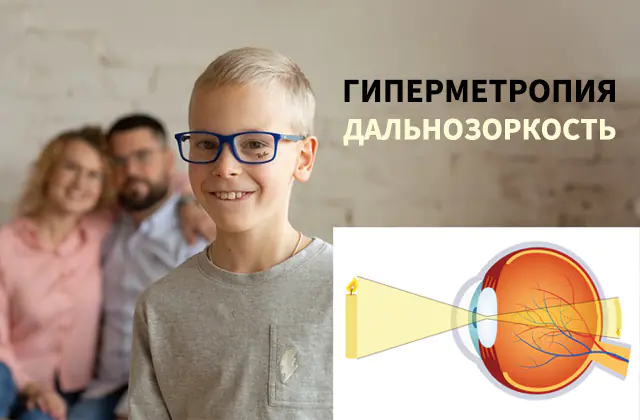
Hypermetropia - what is it, what are the causes of farsightedness in a child. Manifestations of the disease and complications. Methods for diagnosing and treating hypermetropia in children. Prevention measures.
The content of the article:- Reasons for appearance
- Degrees and symptoms of hypermetropia in children
- Diagnostic methods
- Treatment options
- Optical instruments
- Eye exercises
- Vitamins
- Hardware procedures
- Prevention
Hypermetropia in children is a vision defect in which light rays are focused outside the retina. Because of this, the child clearly sees distant objects, but has difficulty viewing near objects. Farsightedness is considered normal for children under 4 years of age. If a disease is detected in a schoolchild, therapeutic measures are prescribed to correct it.
- Read about hypermetropia in adults
Causes of hypermetropia in a child
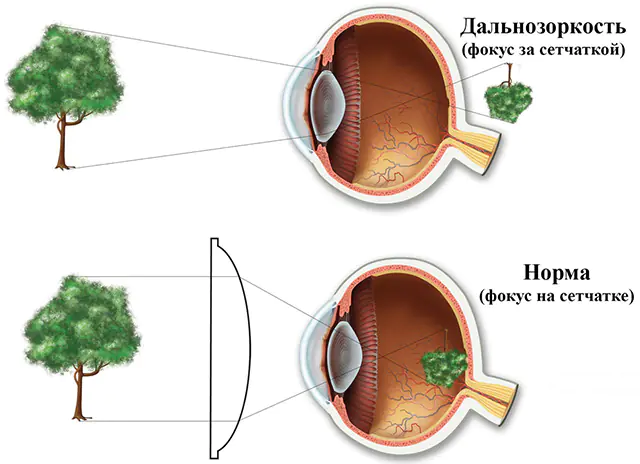
Several parts of the eye take part in the focusing process: lenses, muscles, ligaments. For proper refraction of rays, the size of the eyeball and the health of the cornea are important. Violation of their work leads to the appearance of hypermetropia.
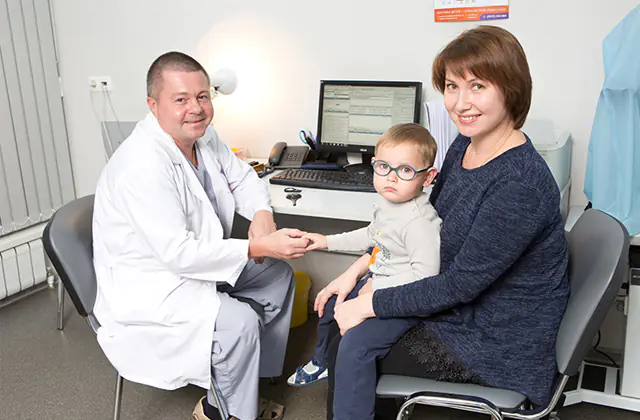
The photo shows hypermetropia in a child
Causes of farsightedness in children:
- Anatomical abnormalities. Small children grow unevenly and spasmodically. Their internal organs may be disproportionately small or large in size. This growth feature affects many body functions, including the focusing of light rays.
- Intrauterine diseases. During pregnancy, a woman should give up bad habits, long trips, and visiting crowded places during a flu epidemic. Otherwise, an infection may enter the fetus’s body, causing mutation and underdevelopment of parts of the eye.
- Fatigue of the visual organs. Some parents allow their children to watch TV for a long time or play games on their phones and tablets. This pastime keeps the baby occupied and allows adults to do household chores. However, it puts a huge strain on the child’s vision and provokes the development of farsightedness and other ophthalmological diseases.
The causes of hypermetropia in children also include a genetic predisposition to the disease. Therefore, parents with congenital farsightedness should closely monitor the health of their child’s eyes: identify the pathology in time, follow the doctor’s instructions to slow its progression.
Degrees and symptoms of hypermetropia in children
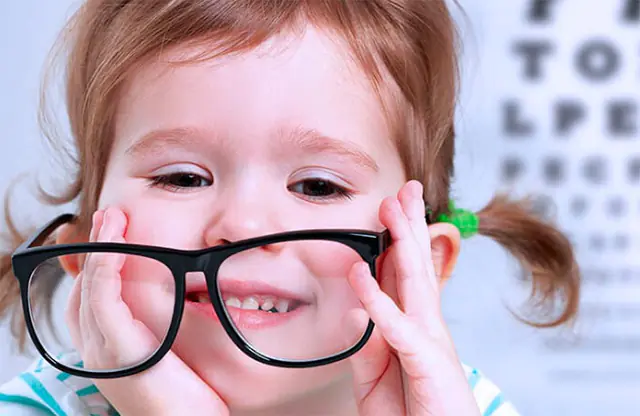
The intensity of the symptoms of farsightedness depends on the stage of development of the disease. There are three degrees of progression of hypermetropia in children:
- weak - up to 2 diopters;
- medium - up to 5 diopters;
- high - over 5 diopters.
Ophthalmologists note that children cannot clearly express their complaints. Therefore, parents must themselves recognize the signs of deterioration in visual acuity.
The most common manifestation of hypermetropia in childhood is rapid eye fatigue. It is expressed in:
- frequent rubbing of eyelids with fingers;
- refusal to read and look at pictures;
- involuntary removal of a book in an outstretched hand;
- headaches after working with small objects;
- capriciousness, tearfulness of the baby.
Children over 6 years old can already talk about headaches and eye pain while studying and doing homework. Hearing such complaints, parents often blame overwork and the complexity of the school curriculum. However, when therapeutic measures are taken to correct hypermetropia, the well-being of adolescents improves. Their average grade increases, the number of corrections and errors in notebooks decreases.
Without treatment, childhood hypermetropia is complicated by the following diseases of the visual organs:
- Conjunctivitis. With farsightedness, children's eyes experience increased strain. Overexertion causes a dull ache, a feeling of sand or a foreign object. Rubbing the eyelids with dirty hands causes the development of inflammatory diseases. In addition to conjunctivitis, these include blepharitis, chalazion, and stye.
- Strabismus. When writing, reading, or working with small objects, a person’s pupils move slightly toward the bridge of the nose. The eyes of a child suffering from hypermetropia have weak muscles and ligaments. Because of this, sometimes malfunctions such as strabismus occur - deviation of the visual axes from the point of fixation.
Remember, ignoring the symptoms of hypermetropia and its complications can cause the child to partially or completely lose his vision.
Methods for diagnosing farsightedness in a child
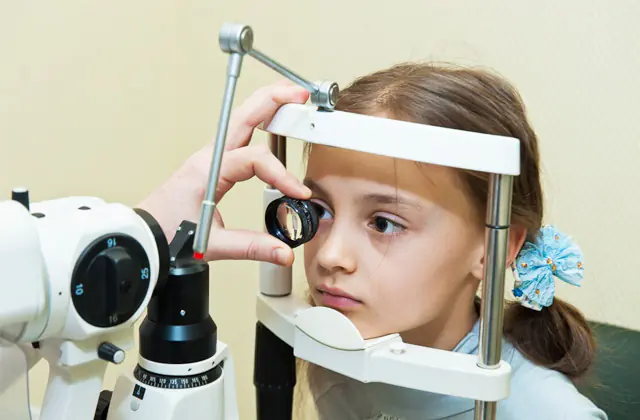
Hypermetropia is often detected at the age of 5-6 years, when the child is preparing for school. Parents notice symptoms of farsightedness and take their child to the doctor. At the appointment, the ophthalmologist examines the eye and refers it to diagnostic procedures:
- Siascopy. The child's eyes are instilled with a drug that dilates the pupil. The doctor turns off the light, leaving only the lamp on behind the baby's back. He points a flashlight at the patient's pupil and watches the movement of the shadow inside the eye.
- Autorefractometry. The child is positioned in front of the slit lamp so that his forehead and chin are fixed. He looks into the camera's lens while the computer takes measurements of parts of his eye. The duration of the procedure is 10-15 minutes.
- Ultrasound of the eye. The child sits on the couch and closes his eyes. An ultrasound device is passed over his eyelids. At the same time, the baby is asked to look left, right, up, down. The results are displayed on the computer screen in the form of a black and white picture.
Despite the fact that all these methods are absolutely painless, they are not used to diagnose small and restless children. Sudden movement, crying, refusal to sit still can change the measurement and devalue the result.
Methods for treating hypermetropia in children
Correction of hypermetropia in children is carried out only in a conservative way. Surgery and laser procedures are performed after adulthood, when the visual organs reach the peak of their development.
Optical devices for correcting farsightedness in children
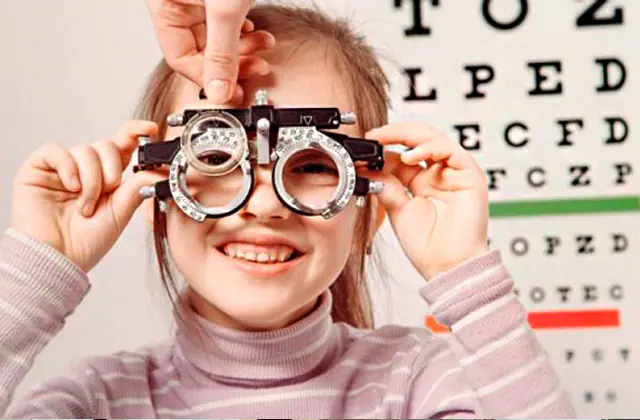
To select glasses, the doctor uses a table with letters or objects of different sizes. The child is located at a distance of 5 meters from the stand, covering one eye with a shutter. He then names the image that the ophthalmologist points to. After determining the degree of development of hypermetropia, the patient “tryes on” the lenses.
For the most effective treatment of farsightedness, children are selected with glasses with a slightly lower diopter. In this way, the work of muscles and ligaments is stimulated to fight the child’s body against the disease. When choosing lenses and frames, it is necessary to take into account the size of the child's head and the distance between his pupils.
After reaching adolescence, children can wear contact lenses to correct farsightedness. These optical devices do not fog up, do not limit your vision, and do not interfere with active sports. Disadvantages include high price, difficulty in operation, and inability to wear during treatment with eye drops.
Eye exercises for hypermetropia in children
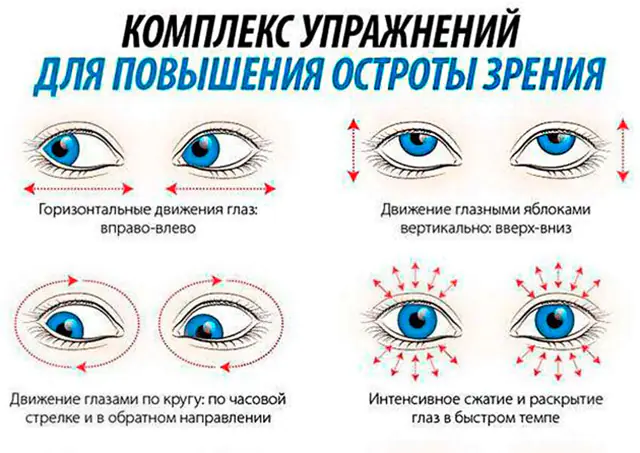
Gymnastics and eye massage train muscles and ligaments, speed up blood circulation in the upper part of the head. As a result, the organs of vision are saturated with oxygen and nutrients, and receive more medicinal components from tablets and drops.
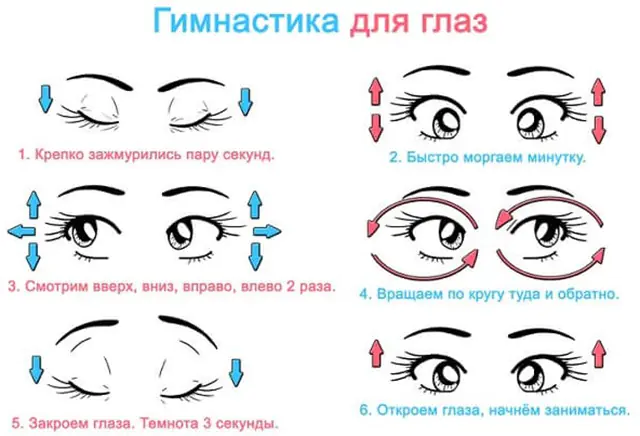
To treat hypermetropia in children, a set of simple exercises is used:
- Rub your palms together, lightly press them on the eyelids.
- Alternately look up, down, right, left.
- “Draw” with your nose on the table, following an imaginary line.
- Look into the distance through outstretched fingers.
- Alternately look at the glass of the window and at distant objects behind it.
Make sure your child repeats each exercise at least 10 times. After the gymnastics, massage his temples and the skin around the eyelids.
Remember, you can also strengthen your eye muscles while walking while watching birds, planes, and clouds. Read signs with your son/daughter, count the windows of houses, look at small leaves and flowers.
Vitamins for eyes for farsightedness in children
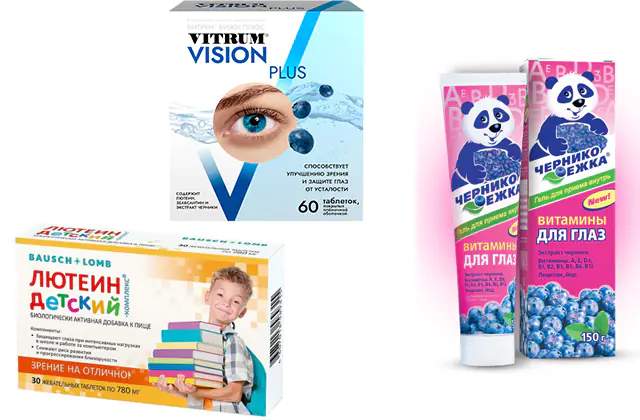
With hypermetropia, the child's eyes are under constant tension. This affects the overall health of the visual organs. To strengthen local immunity, doctors recommend taking vitamin complexes.
Remember, small children are afraid of the instillation process. For them, it is better to buy medicine in the form of lozenges or chewable tablets.
The most effective drugs for children:
- Lutein Children's. The complex contains vitamins A, C, E, lutein, taurine and other substances necessary to protect weakened eyes. The drug is made in the form of chewable tablets (30 pieces) and is prescribed to children over 7 years of age. Price - from 276 rubles in Russia (115 hryvnia in Ukraine) per package.
- blueberry. The vitamin complex is made in the form of a gel, reminiscent of blueberry jam in appearance and taste. In addition to vitamins, it contains extracts of northern berries, lecithin, and calcium iodate. Along with the tube, the package contains instructions and a measuring spoon. Price - from 305 rubles in Russia (160 hryvnia in Ukraine) for 150 ml of product.
- Vitrum Vision. The complex includes vitamins, acids, minerals, carotenoids. They are prescribed to adolescents over 12 years of age with increased loads on the visual organs. To correct farsightedness, the drug is taken once a day for 30 days. Price - from 710 rubles in Russia (380 hryvnia in Ukraine) for 30 tablets.
When healing your eyes with these vitamins and their analogues, you must strictly follow the instructions for the product and do not exceed the prescribed dosage. If an allergic reaction occurs (rash, lacrimation, intestinal disorders), treatment with the drug should be stopped immediately.
Hardware procedures for hyperopia in a child
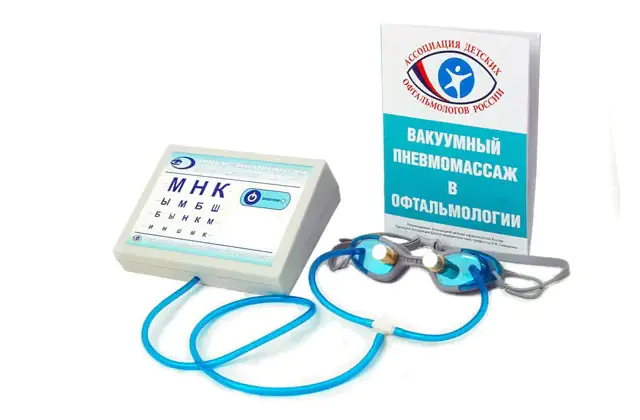
The photo shows a device for vacuum massage in ophthalmology
The visual organs grow and develop until the age of 18. Therefore, to treat hypermetropia in children, hardware procedures are used aimed at correcting their function:
- Vacuum massage. The child sits in a chair and puts on special glasses. The doctor turns on the device, which activates the movement of soft rollers. They delicately massage the eyelids, temples, and skin near the eyes. As a result, blood circulation in the upper part of the head accelerates, the outflow of ocular fluid improves, and the accommodative (focusing) and protective function of the visual system is activated.
- Computer gaming programs. The child sits in front of a computer monitor. The doctor includes a program that, in a playful way, forces the baby to focus on an object, develop the ciliary muscle, and relax the eye ligaments. The most effective recreational games include: “Spider” - building spiral grids that change color during the game; “Cross” - moving a piece on a chessboard, the cells of which also change color; “Contour” - completing the drawing of silhouettes of objects, animals, patterns; “Flower” - search for a given symbol that is hidden on flower petals. During the session, the doctor monitors the child’s work, explains the rules, and adjusts the difficulty level.
- Autotraining. The child sits in a chair in front of a computer screen. Electrodes are attached to his head to perform an encephalogram. The doctor turns on cartoons, the contrast of which changes depending on the activity of brain structures. The patient does not experience pain, discomfort or other unpleasant sensations.
Prevention of farsightedness in children
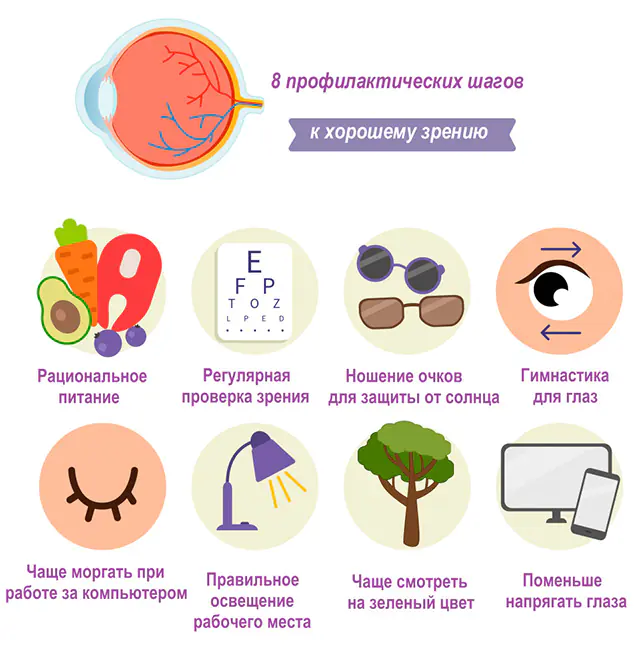
To prevent the development of hypermetropia, monitor your child’s leisure time. Do not allow him to watch TV for a long time or play computer games. Go out with your baby for walks, invite friends over, teach him to play board games with large chips.
While doing homework, turn on a 60-100 W desk lamp. Alternate between writing, reading, studying poetry, and creative assignments. Every 30 minutes of hard work, take a break during which to do eye exercises.
Provide your child with a healthy diet. Make sure his diet includes high-quality fresh ingredients. Include vegetables, fruits, and berries in your daily menu. Buy fermented milk drinks, cottage cheese, honey, and nuts regularly.
Don't skip preventive examinations. Change glasses if your visual acuity worsens or improves. Follow all instructions from the ophthalmologist regarding the dosage of medications and the number of sessions of hardware procedures.
What is hypermetropia in children - watch the video:



